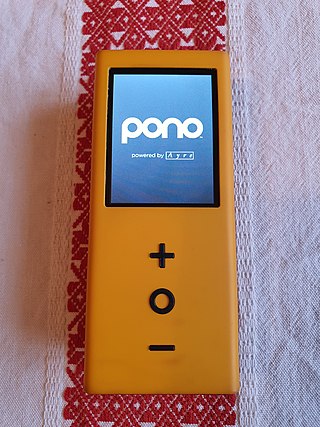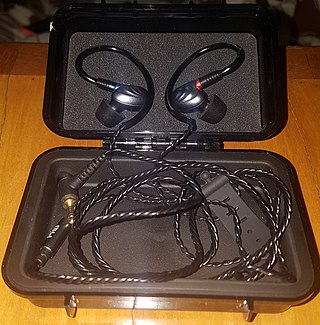Monkey's Audio is an algorithm and file format for lossless audio data compression. Lossless data compression does not discard data during the process of encoding, unlike lossy compression methods such as Advanced Audio Coding, MP3, Vorbis, and Opus. Therefore, it may be decompressed to a file that is identical to the source material.

The iPod Mini is a discontinued, smaller digital audio player that was designed and marketed by Apple Inc. While it was sold, it was the midrange model in Apple's iPod product line. It was announced on January 6, 2004, and released on February 20 of the same year. A second generation version was announced on February 23, 2005, and released immediately. While it was in production, it was one of the most popular electronic products on the market, with consumers often unable to find a retailer with the product in stock. The iPod Mini was discontinued on September 7, 2005 after 1 year of being made, and was replaced by the iPod Nano.
The Apple Lossless Audio Codec (ALAC), also known as Apple Lossless, or Apple Lossless Encoder (ALE), is an audio coding format, and its reference audio codec implementation, developed by Apple Inc. for lossless data compression of digital music. After initially keeping it proprietary from its inception in 2004, in late 2011 Apple made the codec available open source and royalty-free. Traditionally, Apple has referred to the codec as Apple Lossless, though more recently it has begun to use the abbreviated term ALAC when referring to the codec.
ReplayGain is a proposed technical standard published by David Robinson in 2001 to measure and normalize the perceived loudness of audio in computer audio formats such as MP3 and Ogg Vorbis. It allows media players to normalize loudness for individual tracks or albums. This avoids the common problem of having to manually adjust volume levels between tracks when playing audio files from albums that have been mastered at different loudness levels.
WavPack is a free and open-source lossless audio compression format and application implementing the format. It is unique in the way that it supports hybrid audio compression alongside normal compression which is similar to how FLAC works. It also supports compressing a wide variety of lossless formats, including various variants of PCM and also DSD as used in SACDs, together with its support for surround audio.

ZEN is a series of discontinued portable media players designed and manufactured by Creative Technology Limited. The players evolved from the NOMAD brand through the NOMAD Jukebox series of music players, with the first separate "ZEN" branded models released in 2004. The last Creative Zen player, X-Fi3, was released at the end of 2011.

Rockbox is a free and open-source software replacement for the OEM firmware in various forms of digital audio players (DAPs) with an original kernel. It offers an alternative to the player's operating system, in many cases without removing the original firmware, which provides a plug-in architecture for adding various enhancements and functions. Enhancements include personal digital assistant (PDA) functions, applications, utilities, and games. Rockbox can also retrofit video playback functions on players first released in mid-2000. Rockbox includes a voice-driven user-interface suitable for operation by visually impaired users.

A portable media player (PMP) is a portable consumer electronics device capable of storing and playing digital media such as audio, images, and video files. The data is typically stored on a compact disc (CD), Digital Versatile Disc (DVD), Blu-ray Disc (BD), flash memory, microdrive, SD cards or hard drive; most earlier PMPs used physical media, but modern players mostly use flash memory. In contrast, analogue portable audio players play music from non-digital media that use analogue media, such as cassette tapes or vinyl records.
Gapless playback is the uninterrupted playback of consecutive audio tracks, such that relative time distances in the original audio source are preserved over track boundaries on playback. For this to be useful, other artifacts at track boundaries should not be severed either. Gapless playback is common with compact discs, gramophone records, or tapes, but is not always available with other formats that employ compressed digital audio. The absence of gapless playback is a source of annoyance to listeners of music where tracks are meant to segue into each other, such as some classical music, progressive rock, concept albums, electronic music, and live recordings with audience noise between tracks.
The Gigabeat was a line of digital media players by Toshiba.

SanDisk has produced a number of flash memory-based digital audio and portable media players since 2005. The current range of products bear the SanDisk Clip name, a line of ultraportable digital audio players. SanDisk players were formerly marketed under the Sansa name until 2014.

The Zune 4, Zune 8, and Zune 16 are second-generation models of the Zune lineup, they were first announced on October 2, 2007 and released on November 13, 2007 in the United States and June 13, 2008 in Canada. They are flash memory-based players meant to compete with the iPod Nano and the Sansa Fuze, both smaller and cheaper than the three hard drive-based Zune devices, the Zune 30, Zune 80, and Zune 120. They feature music, video, and podcast support, and come with Wi-Fi and FM Radio.

Pono was a portable digital media player and music download service for high-resolution audio. It was developed by musician Neil Young and his company PonoMusic, which raised money for development and initial production through a crowd-funding campaign on Kickstarter. Production and shipments to backers started in October 2014, and shipments to the general public began in the first quarter of 2015.

The ATIV Book 9 is a brand for group of computers that are part of ATIV laptop computer product line from Samsung Electronics Inc. Book 9 is the flagship product of ATIV line up and is designed with performance and portability in mind. All models come with either Intel Core i5 or i7 CPUs and solid-state drive(SSD) storage. The thinnest model of being 13.6 mm (0.54 in) thickness, ATIV Book 9 is among the thinnest laptop computers in the world.
High-resolution audio is a term for audio files with greater than 44.1 kHz sample rate or higher than 16-bit audio bit depth. It commonly refers to 96 or 192 kHz sample rates. However, 44.1 kHz/24-bit, 48 kHz/24-bit and 88.2 kHz/24-bit recordings also exist that are labeled HD Audio.

PonoPlayer is a portable music player created by Neil Young's company, PonoMusic, as the result of a successful Kickstarter campaign.

FiiO X3 is a digital music player manufactured and marketed by FiiO Electronics Technology. The player utilizes a built-in Wolfson DAC, and is capable of reproducing music sampled at 192kHz with a sample size of 24-bits per channel, in addition to functioning as a USB audio interface. The X3 is a mid-level member of the FiiO X Series of portable music players. It supports major lossy music formats such as MP3, and lossless music formats such as FLAC.
Astell & Kern is a South Korean consumer electronics company founded in October 2013, and is wholly owned by Dreamus. The company manufactures media players, CD players, headphones, and home cinema products. It was launched as a premium successor to iriver products.

FiiO F9 and FiiO F9 Pro are noise-isolating earphones manufactured and marketed by FiiO Electronics Technology. They are aimed at listeners who prefer strong bass and are rated as one of the best earphones in its price range by CNET.











